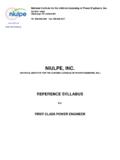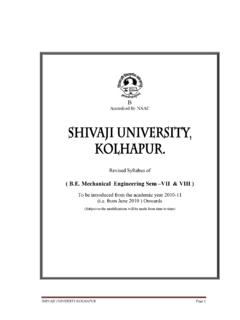Transcription of FUNDAMENTALS PRINCIPLES OF TRANSFORMER …
1 FUNDAMENTAL PRINCIPLES OF TRANSFORMER . thermal loading AND protection . Joe Perez, ERLP hase Power Technologies, Winnipeg, MB, R3Y 1G4. Abstract Power transformers are traditionally protected by differential protection schemes that use voltages and currents to detect abnormalities in the differential zone of protection . For this type of scheme, a short circuit or high magnitude current must be present to initiate a trip. However, this scheme might not be ideal when transformers need to be overloaded to mitigate contingency conditions. Using the IEEE Guide for loading of Oil-Immersed Power transformers , one can thermally rate transformers beyond their nameplate conditions to a level that is safe for operation. Using the guide, engineers can establish continuous, emergency and short term emergency TRANSFORMER ratings. Operators can use these ratings until the contingency conditions are mitigated. However, once the TRANSFORMER has surpassed the short term emergency ratings, the TRANSFORMER might reach critical temperatures and could possibly sustain damage.
2 protection engineers can avoid further TRANSFORMER damage by using the thermal protection PRINCIPLES of the IEEE standard. This paper discusses the fundamental thermal PRINCIPLES of power transformers , philosophies of operations and the implementations of thermal protection . Introduction TRANSFORMER overloads can occur during contingency conditions that are the product of one, two, or various system elements being isolated from the power the system. They can also occur when transformers are already at 80%-90% of their full nameplate rating and extra capacity is needed, especially during hot summers. Depending on a utility's criteria, transformers may be allowed to be overloaded, while still maintaining TRANSFORMER integrity, to keep continuity of the load for economical or reliability reasons. To make these decisions intelligently, we must comprehend the thermal effects that oil and winding temperatures have on the life of insulation. The no-load and load-losses created by the TRANSFORMER core and windings will generate high temperatures that, if not controlled in a timely manner, can damage the dielectric properties of the insulation.
3 During normal operating conditions, the temperature thermal process is controlled by the cooling system that keeps the TRANSFORMER in a thermal equilibrium. TRANSFORMER manufacturers guarantee the longetivity of their product as long as it is operated under the temperature specifications of IEEE or IEC standards. What if transformers need to be loaded beyond normal conditions? How would the standards helps us in this case? The IEEE Guide of loading of Mineral Oil-Immerse transformers aids us in calculating the effect of aging insulation and its exposure to high temperatures. The guide also leads us through the calculation of the winding hottest-spot temperature, which is the driving factor for limiting temperature overloads. Knowing how to calculate the loss of life and the winding hottest-spot temperature is the foundation for the development of dynamic ratings for power transformers . Such ratings can be used by system operators during contingency conditions, which will allow them to overload transformers for a predetermined time.
4 TRANSFORMER dynamic ratings can also be used to create settings criteria for thermal relays. New numerical relays are capable of replicating the thermal model outlined by the IEEE guide, and the relay engineer can set thermal limits based on the dynamic ratings established by the loss of life of insulation and winding hottest-spot calculations. In addition, some thermal relays can predict future temperature states based on constant present values. Such concepts can alarm system operators 15 to 30 mins in advance of a temperature limit violation in the TRANSFORMER , giving them time to mitigate problems. In order to properly apply thermal protection for the power TRANSFORMER , a clear understanding of thermal aspects during overloads is necessary. We must understand the causes for heat, the normal operation limitations, the insulation's loss of life and the hottest-spot temperature; we must also develop philosophies and criteria for TRANSFORMER dynamics ratings. TRANSFORMER Basics: What Affects thermal loading Most professionals in the power industry are very familiar with the fundamental principle of how a TRANSFORMER functions electrically.
5 A TRANSFORMER is a voltage changing device composed of a primary and secondary winding interlinked by a magnetic core (10). A three phase power TRANSFORMER used in transmission and distribution systems shares the same principle. However, its core is bigger to accommodate the three phase primary and secondary windings. Additionally, insulation in the (Copyright 2010 IEEE. Reprinted with permission from the 20010 Texas A&M Relay Conference.). form of oil or paper is required to isolate the difference in potential between phases. Three phase TRANSFORMER losses will generate enough heat so that external cooling systems must be added. A closer look at these characteristics is necessary to better understand the thermal aspects of power transformers . The Core and Windings When one thinks of a TRANSFORMER core, one usually visualizes it as a piece of solid metal. On the contrary, the core is built up by horizontally or vertically stacking thin iron laminations or sheets, which eventually form the core's leg and yoke, as seen in Figure 1 (5).
6 The primary function of the TRANSFORMER core is to provide a low reluctance path for the flux that links the primary and secondary windings. Ideally, we would like a zero reluctance flux path between the two windings. However, due to the iron laminations that form the core, the TRANSFORMER core experiences losses that eventually produce heat. These core losses can be classified as hysteresis and eddy current losses. See the section on TRANSFORMER losses, below, for further details. Yoke Leg Figure 1. Three Phase TRANSFORMER Core. Insulation Insulation is required whenever there is a difference in potential between two points (7). In an overhead three phase transmission line with bare conductors, no insulation is necessary between the conductors since air separation is used as an insulator, preventing the flow of current. However, in power transformers , distance between phase conductors is not an efficient way of separating the potential differences. As a result, paper is used as an insulator, allowing closer proximity between phases and thus maximizing space.
7 By far, paper is the best insulating material used today because of its high dielectric strength properties (10). Paper insulation in a power TRANSFORMER is installed between windings of the same phase, windings to ground, and windings from different phases (7). Other parts of the TRANSFORMER also experience a difference in potential, such as the TRANSFORMER tank wall with the windings, which also requires some form of insulation. In order to minimize the TRANSFORMER 's footprint, this distance must be shortened as much as possible. TRANSFORMER manufacturers shorten the necessary distance by using insulating oil, which not only insulates, but also serves as a coolant within the TRANSFORMER (5). Thus, TRANSFORMER insulation is the heart of TRANSFORMER design, and maximum TRANSFORMER performance during loading depends on the insulation's credibility. TRANSFORMER losses are one of the primary factors affecting this credibility, which is the focus of the next section.
8 TRANSFORMER Losses Even though transformers are very efficient devices, converting from 95-99% of their input power, some of its energy is lost during the voltage transformation (10). The losses in a power TRANSFORMER can be classified as no-load losses and load losses. No-Load Losses. With no load in the secondary windings, an energized TRANSFORMER behaves as a highly inductive element, similar to a shunt reactor. In order to keep this TRANSFORMER energized, the alternating excitation current is drawn from the system, producing an alternating mutual flux in the primary winding. This mutual flux is taken by the core at a rate that depends on the system frequency. The energy requirements for this cyclic magnetization of the core results in two types of TRANSFORMER losses: eddy and hysteresis losses. Induced voltage in the laminations produced by the alternating flux results in undesirable currents within the laminations. Such currents are called eddy currents, which do not contribute to power output, and their energy is lost to heat (10).
9 The alternating magnetization of the core will cause the molecular composition of the iron core to align itself with the changing field. The energy lost from successive reversal of magnetization in the core is called hysteresis loss (4). Load Losses. The load losses in a power TRANSFORMER are due to the electric resistance of windings and stray losses. The resistive action of the winding conductor to the current flow will be lost in the form of heat and will be dissipated in the surrounding area inside the TRANSFORMER . The magnitude of that loss increases by the square of the current . Stray losses occur due to the leakage field of winding and due to high currents seen in internal structural parts such as bus bars. Stray losses can affect the overall rating of the TRANSFORMER because they can create hot spots when the current leads become excessive, affecting the overall life of the TRANSFORMER (10). (Copyright 2010 IEEE. Reprinted with permission from the 20010 Texas A&M Relay Conference.)
10 Heat Transfer Effects A load serving TRANSFORMER not only experiences an electrical process but also goes through a thermal process that is driven by heat. The heat generated by the no-load and load losses is the main source of temperature rise in the TRANSFORMER . However, the losses of the windings and stray losses seen from the structural parts are the main factors of heat generation within the TRANSFORMER . The thermal energy produced by the windings is transferred to the winding insulation and consequently to the oil and TRANSFORMER walls. This process will continue until an equilibrium state is reached when the heat generated by the windings equals the heat taken away by some form of coolant or cooling system (4). This heat transfer mechanism must not allow the core, windings, or any structural parts to reach critical temperatures that could possibly deteriorate the credibility of the winding insulation. The dielectric insulating properties of the insulation can be weakened if temperatures above the limiting values are permitted (10).





